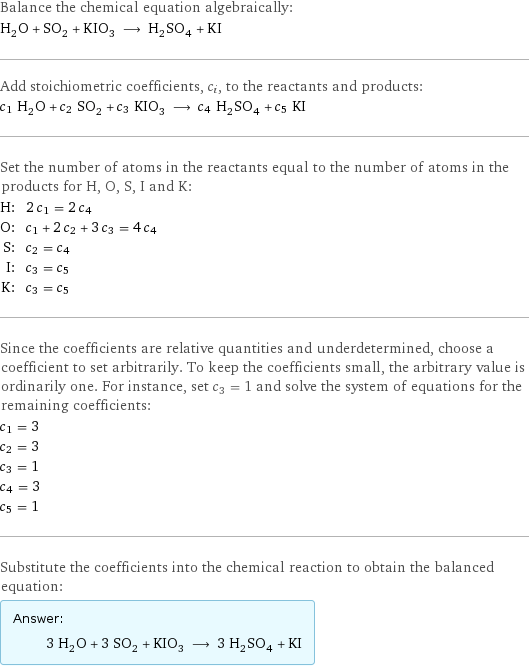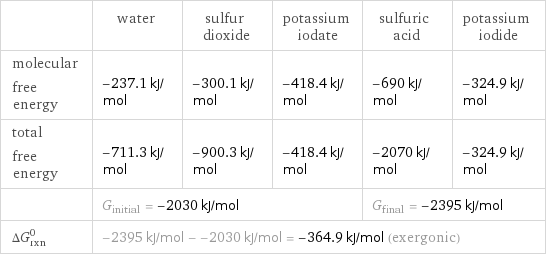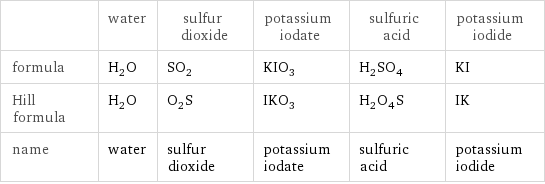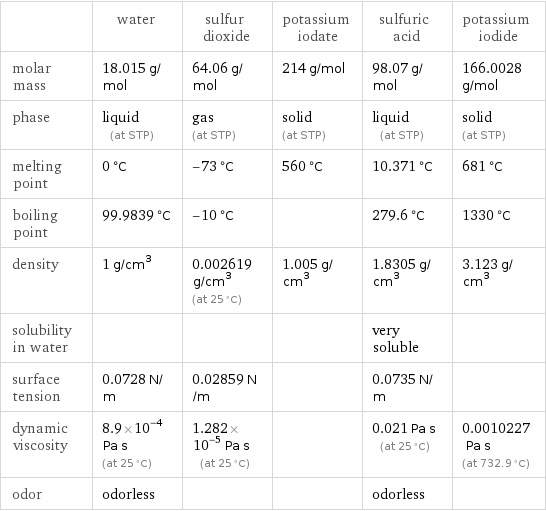Input interpretation

H_2O water + SO_2 sulfur dioxide + KIO_3 potassium iodate ⟶ H_2SO_4 sulfuric acid + KI potassium iodide
Balanced equation

Balance the chemical equation algebraically: H_2O + SO_2 + KIO_3 ⟶ H_2SO_4 + KI Add stoichiometric coefficients, c_i, to the reactants and products: c_1 H_2O + c_2 SO_2 + c_3 KIO_3 ⟶ c_4 H_2SO_4 + c_5 KI Set the number of atoms in the reactants equal to the number of atoms in the products for H, O, S, I and K: H: | 2 c_1 = 2 c_4 O: | c_1 + 2 c_2 + 3 c_3 = 4 c_4 S: | c_2 = c_4 I: | c_3 = c_5 K: | c_3 = c_5 Since the coefficients are relative quantities and underdetermined, choose a coefficient to set arbitrarily. To keep the coefficients small, the arbitrary value is ordinarily one. For instance, set c_3 = 1 and solve the system of equations for the remaining coefficients: c_1 = 3 c_2 = 3 c_3 = 1 c_4 = 3 c_5 = 1 Substitute the coefficients into the chemical reaction to obtain the balanced equation: Answer: | | 3 H_2O + 3 SO_2 + KIO_3 ⟶ 3 H_2SO_4 + KI
Structures

+ + ⟶ +
Names

water + sulfur dioxide + potassium iodate ⟶ sulfuric acid + potassium iodide
Reaction thermodynamics
Enthalpy

| water | sulfur dioxide | potassium iodate | sulfuric acid | potassium iodide molecular enthalpy | -285.8 kJ/mol | -296.8 kJ/mol | -501.4 kJ/mol | -814 kJ/mol | -327.9 kJ/mol total enthalpy | -857.5 kJ/mol | -890.4 kJ/mol | -501.4 kJ/mol | -2442 kJ/mol | -327.9 kJ/mol | H_initial = -2249 kJ/mol | | | H_final = -2770 kJ/mol | ΔH_rxn^0 | -2770 kJ/mol - -2249 kJ/mol = -520.6 kJ/mol (exothermic) | | | |
Gibbs free energy

| water | sulfur dioxide | potassium iodate | sulfuric acid | potassium iodide molecular free energy | -237.1 kJ/mol | -300.1 kJ/mol | -418.4 kJ/mol | -690 kJ/mol | -324.9 kJ/mol total free energy | -711.3 kJ/mol | -900.3 kJ/mol | -418.4 kJ/mol | -2070 kJ/mol | -324.9 kJ/mol | G_initial = -2030 kJ/mol | | | G_final = -2395 kJ/mol | ΔG_rxn^0 | -2395 kJ/mol - -2030 kJ/mol = -364.9 kJ/mol (exergonic) | | | |
Equilibrium constant
![Construct the equilibrium constant, K, expression for: H_2O + SO_2 + KIO_3 ⟶ H_2SO_4 + KI Plan: • Balance the chemical equation. • Determine the stoichiometric numbers. • Assemble the activity expression for each chemical species. • Use the activity expressions to build the equilibrium constant expression. Write the balanced chemical equation: 3 H_2O + 3 SO_2 + KIO_3 ⟶ 3 H_2SO_4 + KI Assign stoichiometric numbers, ν_i, using the stoichiometric coefficients, c_i, from the balanced chemical equation in the following manner: ν_i = -c_i for reactants and ν_i = c_i for products: chemical species | c_i | ν_i H_2O | 3 | -3 SO_2 | 3 | -3 KIO_3 | 1 | -1 H_2SO_4 | 3 | 3 KI | 1 | 1 Assemble the activity expressions accounting for the state of matter and ν_i: chemical species | c_i | ν_i | activity expression H_2O | 3 | -3 | ([H2O])^(-3) SO_2 | 3 | -3 | ([SO2])^(-3) KIO_3 | 1 | -1 | ([KIO3])^(-1) H_2SO_4 | 3 | 3 | ([H2SO4])^3 KI | 1 | 1 | [KI] The equilibrium constant symbol in the concentration basis is: K_c Mulitply the activity expressions to arrive at the K_c expression: Answer: | | K_c = ([H2O])^(-3) ([SO2])^(-3) ([KIO3])^(-1) ([H2SO4])^3 [KI] = (([H2SO4])^3 [KI])/(([H2O])^3 ([SO2])^3 [KIO3])](../image_source/5ec21d09b93b87b13c6dfcfe3be393d6.png)
Construct the equilibrium constant, K, expression for: H_2O + SO_2 + KIO_3 ⟶ H_2SO_4 + KI Plan: • Balance the chemical equation. • Determine the stoichiometric numbers. • Assemble the activity expression for each chemical species. • Use the activity expressions to build the equilibrium constant expression. Write the balanced chemical equation: 3 H_2O + 3 SO_2 + KIO_3 ⟶ 3 H_2SO_4 + KI Assign stoichiometric numbers, ν_i, using the stoichiometric coefficients, c_i, from the balanced chemical equation in the following manner: ν_i = -c_i for reactants and ν_i = c_i for products: chemical species | c_i | ν_i H_2O | 3 | -3 SO_2 | 3 | -3 KIO_3 | 1 | -1 H_2SO_4 | 3 | 3 KI | 1 | 1 Assemble the activity expressions accounting for the state of matter and ν_i: chemical species | c_i | ν_i | activity expression H_2O | 3 | -3 | ([H2O])^(-3) SO_2 | 3 | -3 | ([SO2])^(-3) KIO_3 | 1 | -1 | ([KIO3])^(-1) H_2SO_4 | 3 | 3 | ([H2SO4])^3 KI | 1 | 1 | [KI] The equilibrium constant symbol in the concentration basis is: K_c Mulitply the activity expressions to arrive at the K_c expression: Answer: | | K_c = ([H2O])^(-3) ([SO2])^(-3) ([KIO3])^(-1) ([H2SO4])^3 [KI] = (([H2SO4])^3 [KI])/(([H2O])^3 ([SO2])^3 [KIO3])
Rate of reaction
![Construct the rate of reaction expression for: H_2O + SO_2 + KIO_3 ⟶ H_2SO_4 + KI Plan: • Balance the chemical equation. • Determine the stoichiometric numbers. • Assemble the rate term for each chemical species. • Write the rate of reaction expression. Write the balanced chemical equation: 3 H_2O + 3 SO_2 + KIO_3 ⟶ 3 H_2SO_4 + KI Assign stoichiometric numbers, ν_i, using the stoichiometric coefficients, c_i, from the balanced chemical equation in the following manner: ν_i = -c_i for reactants and ν_i = c_i for products: chemical species | c_i | ν_i H_2O | 3 | -3 SO_2 | 3 | -3 KIO_3 | 1 | -1 H_2SO_4 | 3 | 3 KI | 1 | 1 The rate term for each chemical species, B_i, is 1/ν_i(Δ[B_i])/(Δt) where [B_i] is the amount concentration and t is time: chemical species | c_i | ν_i | rate term H_2O | 3 | -3 | -1/3 (Δ[H2O])/(Δt) SO_2 | 3 | -3 | -1/3 (Δ[SO2])/(Δt) KIO_3 | 1 | -1 | -(Δ[KIO3])/(Δt) H_2SO_4 | 3 | 3 | 1/3 (Δ[H2SO4])/(Δt) KI | 1 | 1 | (Δ[KI])/(Δt) (for infinitesimal rate of change, replace Δ with d) Set the rate terms equal to each other to arrive at the rate expression: Answer: | | rate = -1/3 (Δ[H2O])/(Δt) = -1/3 (Δ[SO2])/(Δt) = -(Δ[KIO3])/(Δt) = 1/3 (Δ[H2SO4])/(Δt) = (Δ[KI])/(Δt) (assuming constant volume and no accumulation of intermediates or side products)](../image_source/a265547bf56e2dd02eac2a3aaf2dcd96.png)
Construct the rate of reaction expression for: H_2O + SO_2 + KIO_3 ⟶ H_2SO_4 + KI Plan: • Balance the chemical equation. • Determine the stoichiometric numbers. • Assemble the rate term for each chemical species. • Write the rate of reaction expression. Write the balanced chemical equation: 3 H_2O + 3 SO_2 + KIO_3 ⟶ 3 H_2SO_4 + KI Assign stoichiometric numbers, ν_i, using the stoichiometric coefficients, c_i, from the balanced chemical equation in the following manner: ν_i = -c_i for reactants and ν_i = c_i for products: chemical species | c_i | ν_i H_2O | 3 | -3 SO_2 | 3 | -3 KIO_3 | 1 | -1 H_2SO_4 | 3 | 3 KI | 1 | 1 The rate term for each chemical species, B_i, is 1/ν_i(Δ[B_i])/(Δt) where [B_i] is the amount concentration and t is time: chemical species | c_i | ν_i | rate term H_2O | 3 | -3 | -1/3 (Δ[H2O])/(Δt) SO_2 | 3 | -3 | -1/3 (Δ[SO2])/(Δt) KIO_3 | 1 | -1 | -(Δ[KIO3])/(Δt) H_2SO_4 | 3 | 3 | 1/3 (Δ[H2SO4])/(Δt) KI | 1 | 1 | (Δ[KI])/(Δt) (for infinitesimal rate of change, replace Δ with d) Set the rate terms equal to each other to arrive at the rate expression: Answer: | | rate = -1/3 (Δ[H2O])/(Δt) = -1/3 (Δ[SO2])/(Δt) = -(Δ[KIO3])/(Δt) = 1/3 (Δ[H2SO4])/(Δt) = (Δ[KI])/(Δt) (assuming constant volume and no accumulation of intermediates or side products)
Chemical names and formulas

| water | sulfur dioxide | potassium iodate | sulfuric acid | potassium iodide formula | H_2O | SO_2 | KIO_3 | H_2SO_4 | KI Hill formula | H_2O | O_2S | IKO_3 | H_2O_4S | IK name | water | sulfur dioxide | potassium iodate | sulfuric acid | potassium iodide
Substance properties

| water | sulfur dioxide | potassium iodate | sulfuric acid | potassium iodide molar mass | 18.015 g/mol | 64.06 g/mol | 214 g/mol | 98.07 g/mol | 166.0028 g/mol phase | liquid (at STP) | gas (at STP) | solid (at STP) | liquid (at STP) | solid (at STP) melting point | 0 °C | -73 °C | 560 °C | 10.371 °C | 681 °C boiling point | 99.9839 °C | -10 °C | | 279.6 °C | 1330 °C density | 1 g/cm^3 | 0.002619 g/cm^3 (at 25 °C) | 1.005 g/cm^3 | 1.8305 g/cm^3 | 3.123 g/cm^3 solubility in water | | | | very soluble | surface tension | 0.0728 N/m | 0.02859 N/m | | 0.0735 N/m | dynamic viscosity | 8.9×10^-4 Pa s (at 25 °C) | 1.282×10^-5 Pa s (at 25 °C) | | 0.021 Pa s (at 25 °C) | 0.0010227 Pa s (at 732.9 °C) odor | odorless | | | odorless |
Units
